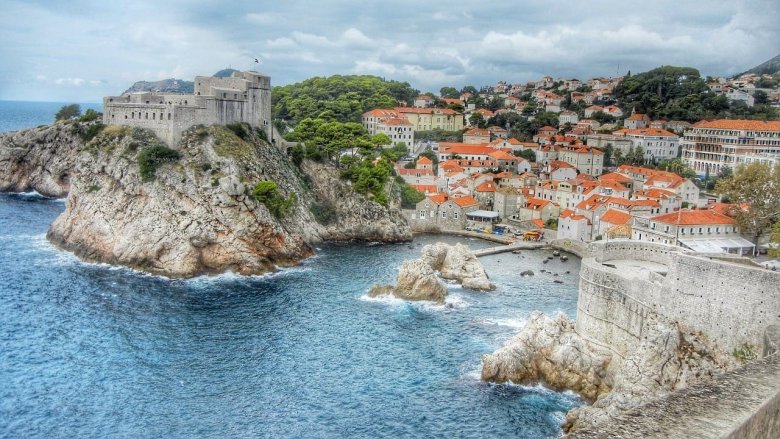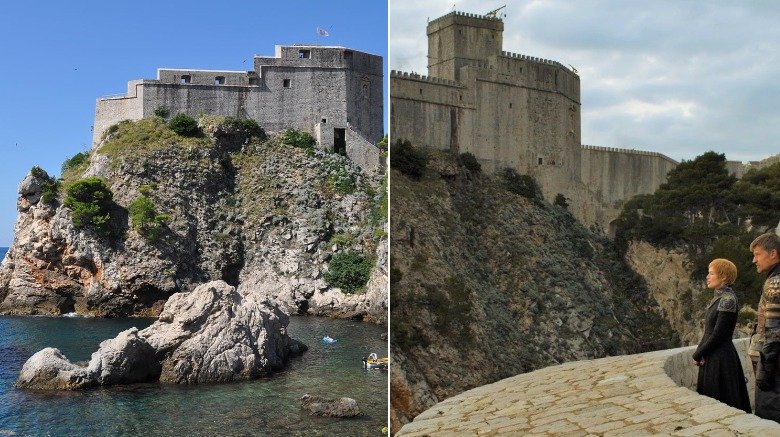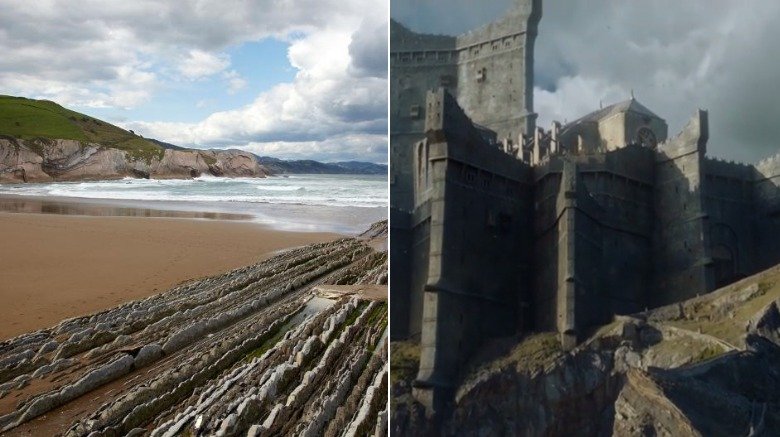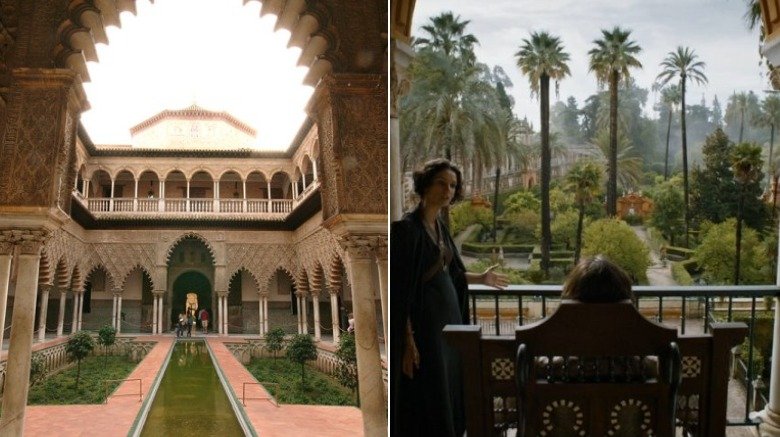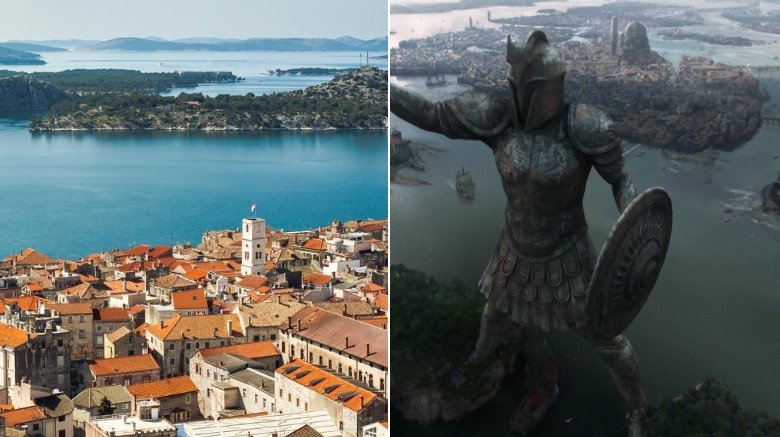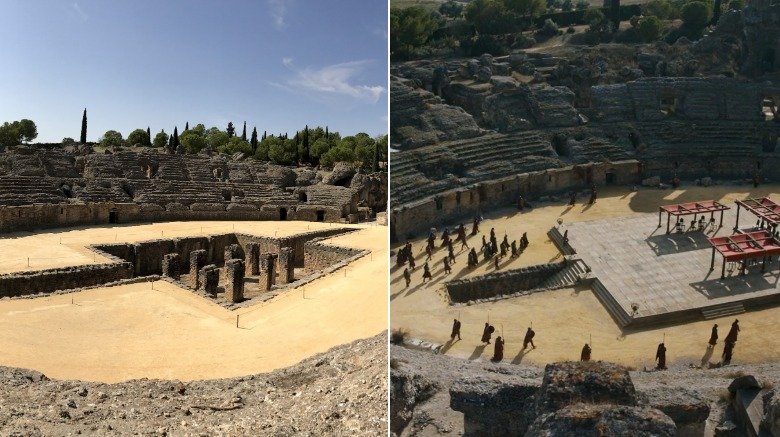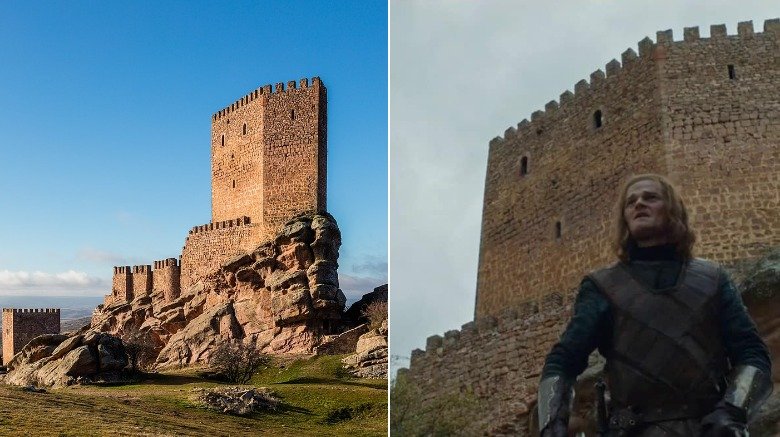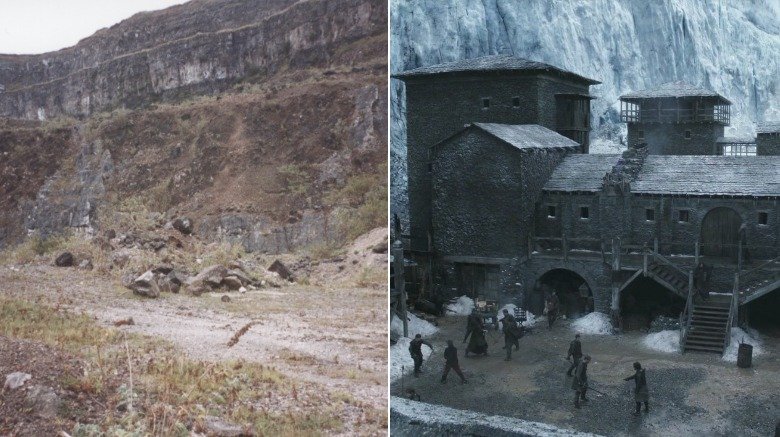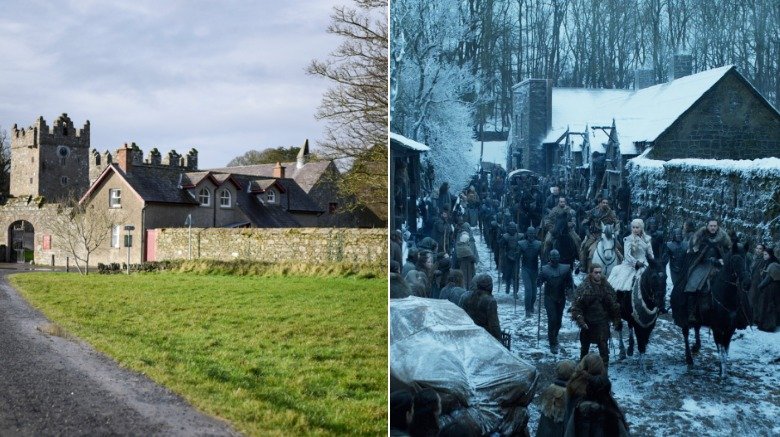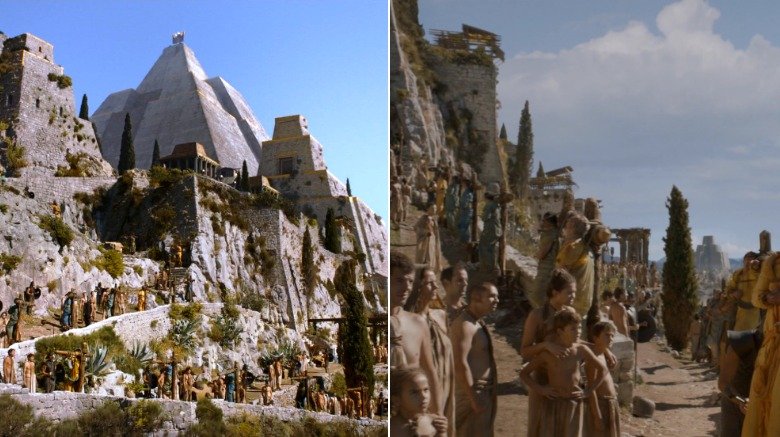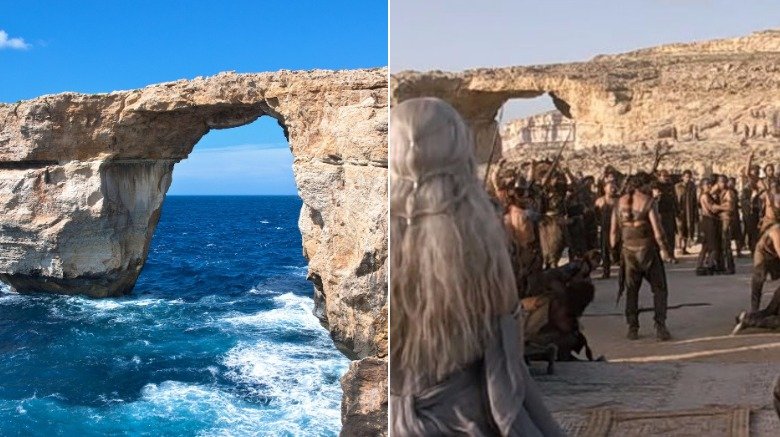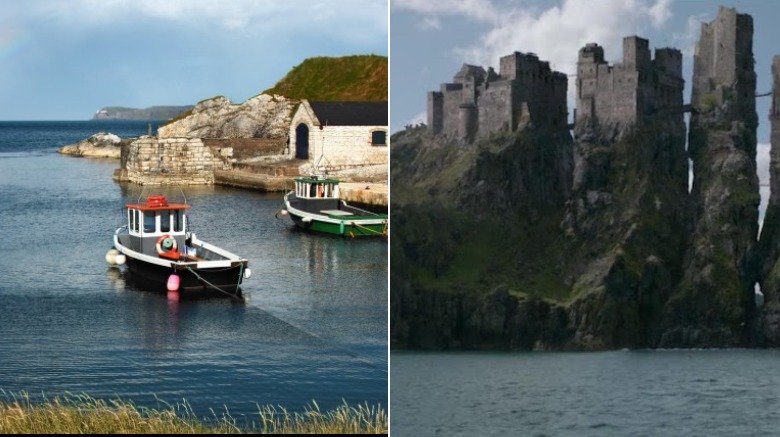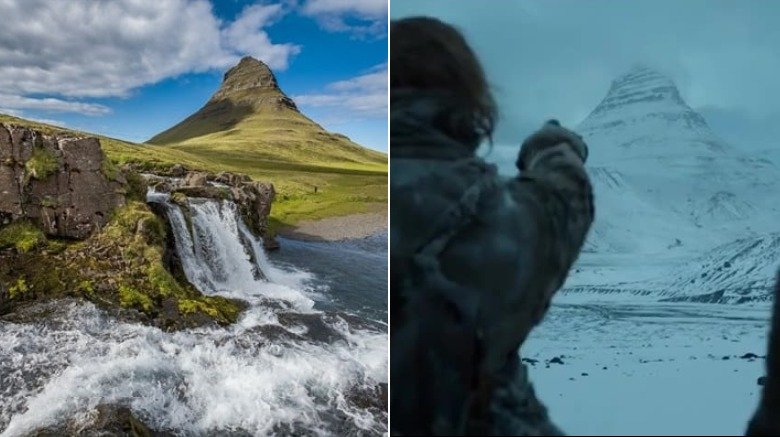What The GoT Film Locations Look Like In Real Life
During its eight-season run, HBO's juggernaut series Game of Thrones was always the most ambitious series on TV, especially when it came to directing, cinematography, and effects. From creating CGI dragons to the prosthetics required for the undead Night King to the huge battle sequences that the cast and crew staged over the years, Thrones consistently smashed both budgets and records, with HBO sparing no expense to make sure its crowning achievement looked amazing. Even as fans were disappointed with a final season rife with inconsistent character choices and super-rushed pacing, the show still looked as gorgeous as ever.
However, there are always going to be things CGI just can't do, and smartly, the crew behind Thrones scouted locations around the world to find some of the planet's most naturally beautiful spots that could serve as stand-ins for the fantastical Westeros created by the series' original author, George R.R. Martin. From ancient cities in Europe to UNESCO World Heritage Sites to the wilderness of Ireland, here's what some of the filming locations used in Game of Thrones actually look like and the history and stories behind them.
Dubrovnik, Croatia (King's Landing)
As the capital city of the Seven Kingdoms, King's Landing, where characters like Cersei Lannister (Lena Headey) and her minions protect the Iron Throne at all costs, is one of the most beautiful cities in the Realm (despite overcrowding and rampant poverty). Luckily, there was a perfect real-life stand-in for King's Landing available for filming. So if you want to visit the real place, make your way to Dubrovnik, Croatia and explore the castle walls and small streets of the Old Town that you've seen since Season 2 (before that, Malta was used as the capital). Thanks to its ancient structures and picturesque orange roofs, Dubrovnik looks like it's straight out of a fantasy novel, and ever since Thrones began filming on location there, it's become a huge tourist destination, with fans clamoring to follow in the footsteps of their favorite characters.
However, using Dubrovnik did eventually present one surprising challenge: when the city needed to be destroyed by Daenerys' dragon in Season 8, the producers realized they couldn't actually raze a UNESCO World Heritage Site. So in order to stage the siege of King's Landing, they meticulously rebuilt the streets of Dubrovnik in Belfast, pulling off one of the show's most impressive technical feasts.
Itzurun Beach, Spain (Dragonstone)
The ancestral island home of the royal Targaryen family, Dragonstone, like King's Landing, sits on Blackwater Bay, although the two couldn't be more different in both scope and atmosphere. The dark, brooding castle of Dragonstone begins the series occupied by Stannis Baratheon (Stephen Dillane); it was given to him by his brother, King Robert Baratheon, after the two overthrew the Targaryens. Though he occupies it for quite a while, he is ultimately taken down by Brienne of Tarth (Gwendoline Christie). Daenerys Targaryen (Emilia Clarke) does return to her rightful home at the beginning of the seventh season, using it as a home base for her own strategy sessions (and taking over the throne room). But she doesn't have it for long, and seeing as she also didn't survive Thrones, it's likely that Dragonstone became empty once again.
Located just outside of the small town of Zumaia in Spain's Basque Country, Itzurun Beach is tucked away behind a range of mountains, which is precisely what makes it so notable; the rock strata surrounding Itzurun and its neighboring beach, Santiago, are some of the longest continuous rock strata in the entire world. Exploring Dragonstone is interesting enough, but when you walk along this naturally stunning beach, don't forget it has a real-life claim to fame as well.
Alcazar of Seville, Spain (Dorne)
The southern territory of Dorne is a warm, beautiful paradise populated by a different ethnic group than the residents of Winterfell or King's Landing. Traditionally a fairly independent state that's still officially part of Westeros, Dorne has its own royal family, and even though it has a rich and fascinating history, it wasn't a particularly popular addition to the Thrones universe when other characters made journeys there in the fifth season. After Oberyn Martell, the Prince of Dorne, made waves in King's Landing, fans might have been initially excited to visit his region, but once viewers arrived in Dorne to lackluster plotlines and irritating characters, they probably wished they could make a U-turn.
However, at least it has some great-looking scenery, due in large part to the fact that the Thrones crew utilized real, beautiful historical sites as stand-ins for the palaces of Dorne. One particular palace got a lot of play; specifically, the Alcázar of Seville, which was built for Peter of Castile in the 12th century. This beautiful site, which was named a UNESCO World Heritage site in the 1980s, is the perfect place to set Dorne, and at least viewers had something gorgeous to look at during some of Thrones' weaker plotlines.
Šibenik, Croatia (Braavos)
After escaping King's Landing, Westeros' scrappiest fighter, Arya Stark (Maisie Williams), realized she needed to start fresh somewhere new, and luckily, she had the hardware required to do just that. Armed with a mysterious silver coin and a phrase ("Valar morghulis") gifted to her by a faceless assassin named Jaqen H'ghar, Arya is able to book passage to Braavos, a free city located east of Westeros. Home to the House of Black and White as well as the Iron Bank, Arya heads to this new city to track down Jaqen and continue her training. Even though it was difficult to watch her get tormented by her mentors, all of that training eventually paid off with the stealth and quick hand needed to kill the Night King in the eighth season.
Croatia's most popular city, Dubrovnik, might serve as King's Landing, but other smaller (and equally gorgeous) spots in this small country have been backdrops on Thrones as well. Braavos' real life counterpart is the Croatian city of Šibenik, located part-way along the coast near the Adriatic Sea, which is also the oldest native Croatian town along the country's shoreline. Home to a few UNESCO World Heritage sites of its own, Thrones was able to shine an even bigger spotlight on Šibenik, hopefully drawing even more crowds to its shores.
Itálica, Spain (Dragonpit)
Located in King's Landing, the massive, picturesque Dragonpit was once exactly what it sounds like — the stables for the capital's dragons -– but as the dragons died out, the pit went largely unused. Left a ruin for most of the show, it made its first appearance during the end of the seventh season, where nearly all of the show's remaining characters met for a summit to discuss the oncoming threat of the Army of the Dead. Proving to be a vital spot for meetings, the Dragonpit comes into play one more time in the series finale, serving as yet another council location, where the fate of the Seven Kingdoms is ultimately decided and Bran Stark (Isaac Hempstead-Wright) is chosen as the new King of Westeros (mostly).
Much like its on-screen counterpart, Itálica, the ruins that serve as the set for the Dragonpit, has been abandoned for years, even though it obviously wasn't used for dragons. However, the site was Roman city that was founded in 206 BC and is located just outside of modern-day Seville, so visitors can still imagine ancient, legendary fights that took place in the city's historic amphitheater.
Castillo de Zafra, Spain (Tower of Joy)
One of the more mysterious sites in all of Westerosi history was the Tower of Joy, a remote castle that was the scene of an important fight during Robert's Rebellion and the overthrow of the Targaryen royal family. During flashbacks he experienced while he trains to become the all-seeing Three-Eyed Raven, Bran visits the Tower of Joy multiple times, watching as a younger version of his father, Ned Stark, and his loyal bannerman Howland Reed fight off Ser Arthur Dayne, who was sworn to protect Prince Rhaegar Targaryen. On the show's final visit to the Tower, audiences get to step inside with Bran, only to discover the secret inside the castle: Lyanna Stark, Ned's sister who secretly married Prince Rhaegar, has given birth to a son and begs Ned to protect the baby before she dies. Of course, that baby turns out to be Ned's alleged bastard, Jon Snow (Kit Harington), the most legitimate heir to the Iron Throne.
Chosen because of its extremely remote location, the Castillo de Zafra, located in Guadalajara, Spain, served as the show's Tower of Joy during the sixth season, providing a backdrop that looked just like fans imagined as far as this important landmark was concerned.
Magheramorne Quarry (Castle Black)
The home to the Night's Watch, originally conceived as a group of banished men who have been permitted to live out their lives after committing some sort of crime, Castle Black is on the border of the far north and the Wall itself, separating men from the Army of the Dead and whatever else might be lurking in this mysterious expanse. The men of the Night's Watch, as punishment for their misdeeds, agree to take no wives and bear no children so that they can devote their lives to the protection of the Realm. As a bastard with no obvious prospects, Jon Snow (Kit Harington) heads there to spend his life in the show's first season, introducing audiences to the large but provincial Castle Black, which reappears frequently throughout the show as one of the most important strongholds of the North.
In real life, Castle Black, like many other Thrones locations, can be found in Ireland in a small settlement called Magheramorne and a nearby abandoned quarry, which included the elevator that lets the Night's Watch men travel up and down the wall, proving that the Thrones crew could transform even the emptiest spaces into something magical.
Doune Castle & Castle Ward (Winterfell)
One of the most important locations in all of Thrones' lore is the castle of Winterfell, the ancestral home of the Stark family and one of the first places viewers see in the pilot episode. The Stark family, who are arguably the show's most prominent and important characters, go their separate ways in the first season and leave Winterfell behind, but eventually, a few return. Sansa (Sophie Turner), Arya, Bran, and Jon end up calling Winterfell their home once more, with Sansa even serving as the Queen in the North and ruling from Winterfell by the series' end. Despite being attacked and nearly destroyed by the Army of the Dead in the final season, Winterfell remained standing, cementing itself as the heart and soul of the entire series.
In the first season, Ireland's Doune Castle, once used for Monty Python and the Holy Grail, was used for some shots of Winterfell, but its most famous location is at Castle Ward, which provided the courtyard that served as a backdrop for some of the show's biggest scenes. Castle Ward, which was the set for the lion's share of Winterfell's sets, even offers Game of Thrones-themed tours around the castle, so you can live out your dreams and walk the halls of Winterfell.
Fortress of Klis at Split, Croatia (Meereen)
During Daenerys' long and arduous journey across Essos and the Narrow Sea to conquer Westeros, she makes some worthwhile stops in cities throughout Slaver's Bay, determined to end the slave trade and provide justice for the oppressed. She ends up spending quite a lot of time in Meereen, one of the three major cities in Slaver's Bay, and after liberating its people, she continues to rule. However, as it turns out, disrupting the slave trade presented plenty of problems, leaving some former slaves lost and adrift and even begging to return to their masters. Faced with a confused populace, angry slave masters, and a mercenary group called the Sons of the Harpy, Daenerys ends up presiding over a city in disarray before leaving Meereen under a subordinate's control and setting off for the Seven Kingdoms.
The Thrones crew returned to Croatia once again to film scenes from Meereen at the Fortress of Klis, a medieval fortress located outside of Split, Croatia. The massive, ancient structure served as the city walls, while scenes on the streets of Meereen, as well as Daenerys' palace there, were filmed within the city of Split, one of the largest cities in Croatia, which is also an extremely popular tourist destination.
Azure Window, Malta (Daenerys & Drogo's wedding)
However, before Daenerys set off to conquer faraway lands, she was just a young, naive bride married off to Khal Drogo (future Aquaman star Jason Momoa), a fierce warlord and leader of the Dothraki tribe of horse lords and warriors. Though the two eventually fall in love, with Drogo promising to conquer the Seven Kingdoms for his queen, they got off to a rocky start thanks to a language barrier (and one of Thrones' earliest problematic scenes). During their wedding and wedding night, the two couldn't even communicate with each other.
Despite the upsetting scene, Daenerys and Drogo's wedding couldn't have been set in a more picturesque location, which was once in Malta known as the Azure Window. One of Malta's most popular tourist attractions, the structure suffered from rampant erosion due to tourism and natural effects, and in the spring of 2017, the entire structure ended up collapsing. Thrones fans may not be able to visit the Azure Window anymore, but at least it lives on in the series.
Ballintoy Harbour (The Iron Islands)
Home to House Greyjoy, the Iron Islands are located off the western coast of the Seven Kingdoms' mainland and are populated with a small yet fierce group renowned for their sailing capabilities. The main Greyjoys in the show spend a considerable amount of time fighting for control of the Islands, even after an incident during Robert's Rebellion where Balon Greyjoy, King of the Iron Islands, was punished for rebelling against the Iron Throne and was ultimately forced to give up his son Theon (Alfie Allen) as a ward who went on to live in the North. However, Theon, his sister Yara (Gemma Whelan), and their murderous uncle Euron (Pilou Asbæk) spend most of the series squabbling over leadership of the Iron Islands, all claiming to have the right to reign supreme over these far-flung islands.
Using locations in Northern Island, as they did quite frequently during Thrones (the main studios were located in Belfast), the crew found the perfect place to set the Iron Islands: Ballintoy Harbour, located in a town that shares its name. Situated on the coast, it's a perfect stop for any Thrones fan making a tour of Ireland's shores.
Kirkjufell and other Iceland locations (Beyond the Wall)
Beyond the safe confines of Westeros, you'll find the far north, which contains any number of scary, unknown creatures, the most terrifying of which is the Army of the Dead. Typically, humans don't venture beyond the Wall, but occasionally it's necessary. Usually, it's members of the Night's Watch who are sent to perform this daunting task. From dealing with wildlings to trying to capture wights to meeting the Three-Eyed Raven, there are a few reasons to head into the far north, though it's never anybody's first choice.
Shooting on location for the far north required some of the most remote and removed spots in the world, and luckily, the crew found just that in the wilderness of Iceland. If you make a trip to this island nation, you'll be able to see the "arrowhead mountain," known as Kirkjufell, that The Hound (Rory McCann) saw in a vision; step into Jon Snow and Ygritte's (Rose Leslie) cave; and so much more, all without the thread of wildlings or wights lurking around the corner.
